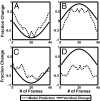Discerning nonrigid 3D shapes from motion cues
- PMID: 21205884
- PMCID: PMC3029717
- DOI: 10.1073/pnas.1016211108
Discerning nonrigid 3D shapes from motion cues
Abstract
Many organisms and objects deform nonrigidly when moving, requiring perceivers to separate shape changes from object motions. Surprisingly, the abilities of observers to correctly infer nonrigid volumetric shapes from motion cues have not been measured, and structure from motion models predominantly use variants of rigidity assumptions. We show that observers are equally sensitive at discriminating cross-sections of flexing and rigid cylinders based on motion cues, when the cylinders are rotated simultaneously around the vertical and depth axes. A computational model based on motion perspective (i.e., assuming perceived depth is inversely proportional to local velocity) predicted the psychometric curves better than shape from motion factorization models using shape or trajectory basis functions. Asymmetric percepts of symmetric cylinders, arising because of asymmetric velocity profiles, provided additional evidence for the dominant role of relative velocity in shape perception. Finally, we show that inexperienced observers are generally incapable of using motion cues to detect inflation/deflation of rigid and flexing cylinders, but this handicap can be overcome with practice for both nonrigid and rigid shapes. The empirical and computational results of this study argue against the use of rigidity assumptions in extracting 3D shape from motion and for the primacy of motion deformations computed from motion shears.
Conflict of interest statement
The authors declare no conflict of interest.
Figures







References
-
- Wallach H, O'Connell DN. The kinetic depth effect. J Exp Psychol. 1953;45:205–217. - PubMed
-
- Sperling G, Dosher BA, Landy MS. How to study the kinetic depth effect experimentally. J Exp Psychol Hum Percept Perform. 1990;16:445–450. - PubMed
-
- Sperling G, Landy MS. Kinetic depth effect and identification of shape. J Exp Psychol Hum Percept Perform. 1989;15:826–840. - PubMed
-
- Domini F, Caudek C. Perceiving surface slant from deformation of optic flow. J Exp Psychol Hum Percept Perform. 1999;25:426–444. - PubMed
-
- Rogers B, Graham M. Motion parallax as an independent cue for depth perception. Perception. 1979;8:125–134. - PubMed
Publication types
MeSH terms
Grants and funding
LinkOut - more resources
Full Text Sources

